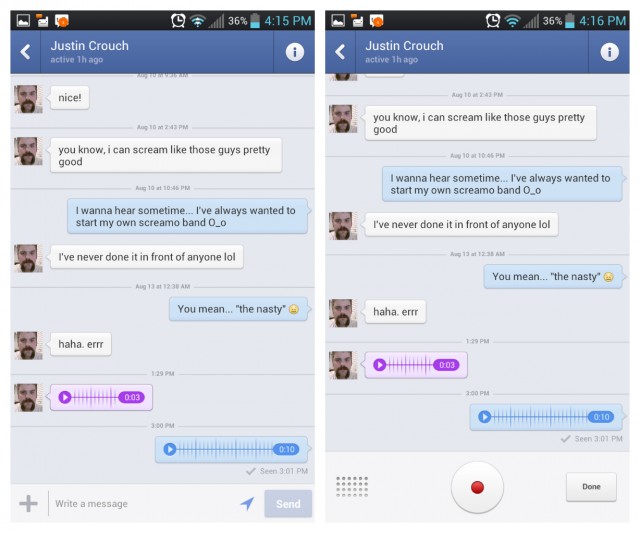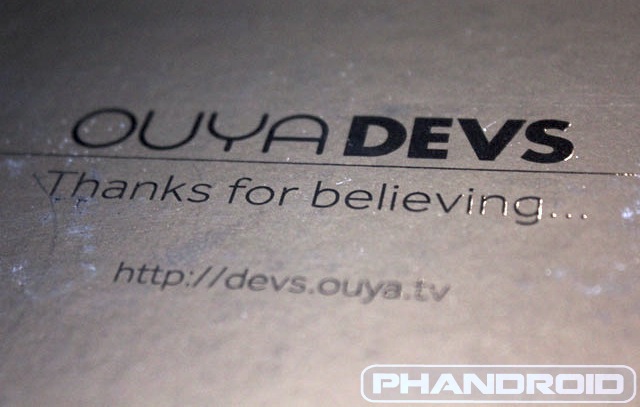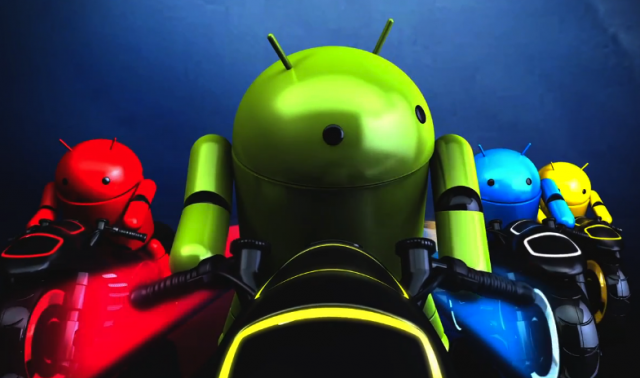Android Phone Fans |
- Facebook Messenger updated with voice messaging, VoIP calls also being tested
- Corning announces Gorilla Glass 3 to be demoed at CES 2013
- Android 4.0+ now on 40% of all Android devices
- First Look: OUYA Developer Console unboxing [PICS]
- Seeder app claims to remove any and all lag from rooted Android devices – Does it work?
- My Galaxy Note 2 suffered a 20-foot drop…
- Motorola says Jelly Bean coming to all Droid RAZR and Droid RAZR MAXX users in Q1 2013
- 5.5 inch LG Optimus G2 coming to CES? [VIDEO]
- YouTube remote control not just a Google TV feature anymore
- Be glad this early Android mascot didn’t make the cut
- Sony Xperia Z pricing revealed?
- 2013 Audit: what’s going on with Google Voice?
- Does a Samsung Tizen phone in 2013 signal a shift away from Android?
- Sprint to bring PAYG service starting January 25th?
- LTE-enabled Samsung Galaxy Note 10.1 shows Verizon support in FCC filing
| Facebook Messenger updated with voice messaging, VoIP calls also being tested Posted: 03 Jan 2013 04:32 PM PST Facebook Messenger is receiving a sizeable update this evening, introducing thumb-happy texters into the world of real voice messaging (that thing you used to use a phone for). Now, jumping into the application and pressing on the “+” icon will pull up the usual set of messaging attachments with “Record Voice” being the newest option. The recipient can then listen to the recorded message at their leisure (this isn’t push-to-talk). While some would likely speculate this is Facebook challenging apps like Voxer I must say, sound quality isn’t anywhere near the clarity of Voxer. Facebook Messenger voice messages sound like your typical cellular gibberish. Pity. Still, there’s no beating it if you’ve got your hands full and need to quickly respond to a Facebook buddy. There’s also talk that Facebook is dabbling in VoIP capabilities for Facebookers in Canada, allowing users to place calls using their phone’s data connection as opposed to cellular voice minutes. Neato. Expect it to arrive stateside in the near future. |
| Corning announces Gorilla Glass 3 to be demoed at CES 2013 Posted: 03 Jan 2013 03:44 PM PST CES is coming just around the bend and we’re already seeing a flood of announcements from companies not wanting to get lost in mayhem that is Las Vegas. When it comes to smartphone protection, Corning is already sending out press releases for their next iteration of Gorilla Glass, the aptly titled Gorilla Glass 3. Last year, Corning showed off Gorilla Glass 2 on the show room floor, promising displays 20% thinner, while providing the same level of protection as their initial offering. With Gorilla Glass 3, Corning is promising a glass material even tougher than before (that’s not saying too much). We’re sure to see demos of knives going at smartphone screens with extreme prejudice. Course, as we all know — you can’t intentionally scratch smartphone glass, it only happens when you’re not looking. Want to convince me your glass is durable? Place it inside my girl friend’s purse for 1 day and watch it come out looking like a ice rink after a long hockey game. Women. Amirite, guys? |
| Android 4.0+ now on 40% of all Android devices Posted: 03 Jan 2013 03:04 PM PST Well, folks, it looks like Gingerbread is finally starting to make a steady descent into the ranks of the obsolete. Well… there’s still a long way to go, but progress is progress! The percentage of Android devices on Gingerbread has finally dipped below 50%. Only about 47.4% of devices remain on the increasingly archaic platform, and while that’s still a heft number considering the hundreds of millions of devices floating about, we have to acknowledge that progress is progress. Froyo, Donut and Eclair all took hits in this two week period ending January 3rd, but it wasn’t enough to write home about. Cupcake has been exiled from the list altogether, and while it provided some good memories back in the days when the HTC Magic and Dream were the only Android devices available I can’t say I’ll miss it at all. The future looks bright, though, as the most modern versions of Android — those running 4.0 and higher — make up nearly 40% of the pie. Specifically, Ice Cream Sandwich is now on 29.1% of all devices, Android 4.1 Jelly Bean is on 9% of all devices, and Android 4.2 is on 1.2% of all devices. It’s tough to realize that Android 4.1 never hit double digits before Android 4.2 launched, but hopefully this’ll play out like the quick jumps between Android 2.3 to 2.3.3, and from Android 2.0.1 to Android 2.1 did. Regardless, most are happy to finally be on the new and improved Holo UI and take advantage of all the 4.0+ exclusive apps that have been sprinkled throughout the Google Play Store as of late. Unless Google slows down to a yearly update schedule then the problem of fragmentation will never die (even that isn’t certain), and that’s just something we’re going to have to learn to live with, folks. Take a look at the breakdown above. [via Android Developers] |
| First Look: OUYA Developer Console unboxing [PICS] Posted: 03 Jan 2013 02:33 PM PST Visit OUYAboards.com for the largest independent community of OUYA enthusiasts! The OUYA has a lot riding on it. As the world’s first Android-powered gaming console, it seems countless “me too” consoles are just now coming out of the woodwork. Still, it’s hard to compete with the sheer amount of backing the OUYA has received from big name game publishers around the world. As official backers (and believers) of the console since its inception, Phandroid and GameFans are two of the first in world to get our hands on the recently shipped OUYA Developer Console — an early dev kit sent to developers so they can ensure their games are compatible with the console (and gamepad) at launch. Here’s what we found inside the little black box. ConsoleThe completely black box had a slick black engraving of “OUYA DEVS” with the nice message of “Thanks for believing…” and the company URL. The first thing you see when opening the box is a thank you letter, leaving you with a warm and fuzzy feeling of being part of something at the ground level. The console itself is teeny tiny, made of plastic, but still pretty darn solid. Much of that sturdy feel comes from the cubed shape and although the “I can see your guts” clearness detracts a bit from the sturdy feel, it’s a pretty cool design for a developer exclusive. On the top right you’ll notice four obviously placed screws: that’s so you can easily crack it open and mod the hardware yourself. Oh yeah OUYA… that’s that’s the Android spirit! GamepadThe look and feel of the controller matched that of the console: plastic but sturdy, aethetically pleasing, and seemingly functional. All the buttons felt like that off top quality console, except for the power button on the console itself. The touchscreen is an interesting… touch, but we’re holding off judgement until it’s time to play some games and use some apps that leverage it’s capabilities. The look of the buttons is nothing short of completely sweet and it pulls together the look, feel, and sound of the OUYA name. The battery covers, located in the handles, were a bit hard to pull off but after that first time cracking them open it was no problemo. There won’t be much to share until games start launching but we’re going to plug this bad boy in and start rocking away. We’ll be back soon with more… but in the meantime:
|
| Seeder app claims to remove any and all lag from rooted Android devices – Does it work? Posted: 03 Jan 2013 01:58 PM PST Lag. It’s something we could all definitely live without. With all these new high-powered quad-core processors hitting the market, you may have noticed that no matter how powerful your device, there’s still a half second (or longer) of time spent waiting for an app to open. I figured this had more to do with slow memory than processing power, but apparently it could also be something else altogether. One dev from XDA went on a search to find out what caused Android lag and cure it forever. What he found was that 90% of Android’s lag was caused by a “limited entropy pool” and cooked up a simple app to seemingly eliminate all lag found on a device when opening bigger, memory intensive applications like Facebook, Chrome, Maps, etc.. The app — which can be downloaded from either the original post on XDA or from Google Play — is compatible with all Android versions, and all Android devices. Unfortunately, I haven’t been able to give the app a spin as I’m currently unrooted (gasp!), but this is as good a reason as any to find a nice toolkit. That is, if we aren’t looking at nothing more than placebo here. Let me know if you guys notice any speed increases. Thanks, @JonathanMallett! [via XDA | Google Play] |
| My Galaxy Note 2 suffered a 20-foot drop… Posted: 03 Jan 2013 01:42 PM PST …and it came out 100% fine thanks to that case up above. It’s not often you get a chance to test out the claims of a protective case, but I had the unfortunate opportunity to find out that my choice — a generic metal bumper case for the Samsung Galaxy Note 2 — lives up to expectations. Many people like to “go naked” and risk their phones’ protection in order to enjoy their natural good looks. I’m one of those people, but as clumsy as I am (Rob and the rest of the gang know all about it) I knew I had to protect this $750 investment at all times. I hate full body cases, so I opted for a bumper instead. I knew it could absorb impact well due to its metal body, and the .25 centimeter-thick buffer on either side of the bumper and every corner of the device meant there was a high chance my device could survive first impact no matter which corner or side hit first. Cases with shock buffering are nothing new, of course, but it’s the height at which I dropped it, and the surface it smacked against — face down on cold, hard concrete — that surprised me. I got the case for minor drops (no less than about 3 feet and no higher than about 5.9 feet) so when this 5.5 inch beast came tumbling out of my pocket, over a railing and hurdled face first into concrete I was all but certain I’d lost nearly a month’s worth of rent in just a few short seconds. While I don’t mean for this to be a review of the case in question (you can buy it here if you’re interested anyway), my real message is for those who feel like desecrating their phones with cases is silly. Take it from someone who planned on treating this thing like a baby for at least the next year — the peace of mind and added protection certainly is worth the girth. The case didn’t fare well post-impact, but I’ll only need to shell out another $30 as opposed to $750, and it’s one repurchase that I won’t hesitate to make at all. |
| Motorola says Jelly Bean coming to all Droid RAZR and Droid RAZR MAXX users in Q1 2013 Posted: 03 Jan 2013 01:22 PM PST
After a select group of Motorola Droid RAZR and Droid RAZR MAXX users received a Christmas gift in the form of Android 4.1.2, the update ceased without explanation. We can’t say for sure why Motorola halted the software upgrade, but we now have confirmation that Motorola plans to deliver Jelly Bean to all users of the RAZR and RAZR MAXX sometime in Q1 of this year. The news was posted to the comments section of a post touting Jelly Bean for the Droid RAZR M on the Motorola Facebook page. No specifics were offered as to when exactly in Q1 we can expect to see the Android 4.1 update begin anew. We’re in Q1 now, so Jelly Bean could touch down as soon as tomorrow or as late as March. Let’s hope the latter isn’t the case. If a major bug was discovered at the last minute, it could be a while before we see the update reach handsets. On the other hand, if the software only needed a few minor tweaks expect it much sooner. [via Facebook | Thanks, Dave!] |
| 5.5 inch LG Optimus G2 coming to CES? [VIDEO] Posted: 03 Jan 2013 12:42 PM PST We’ve heard about a lot of great new devices making their way to CES next week, but things have been a bit quiet from LG’s camp. That was, of course, until DigiTimes claims to have word that LG will launch a 5.5 inch superphone at the global trade show. The company is said to be launching a follow-up to the LG Optimus G. Simply dubbed “LG Optimus G2,” this new device looks to challenge Samsung’s Galaxy Note 2 even more with its 5.5-inch HD display (no word on resolution) and a quad-core Qualcomm S4 Prime processor. LG definitely seems to be prepping for a big unveil as it has launched a teaser video showing quick close-ups of a device that was too obscured to make out. Well… like all devices in the past 5 years it seems to be rectangular, but that’s all that we can tell about it for sure. The :20 mark of the video above shows the mystery device sitting on a showcase tower, and some have reason to believe that the space beneath it is holding up a possible tablet dock ala the ASUS Padfone 2. That’s just pure speculation, though, so don’t read too deeply into that right now. Just know that LG will be looking to steal the show in Vegas next week, and they could be walking away with some nice “best of” honors if other smartphone OEM players don’t show up with anything compelling. Phandroid is headed to CES, of course, and you can bet LG will be one of our first stops to bring you a first hand look at everything the South Korean electronics manufacturer has to offer. Be sure to stick around all throughout CES week for the goods. PS: LG, I totally forgive you for this teaser that looks like it was inspired from 1980s flea market commercials. [via DigiTimesp] |
| YouTube remote control not just a Google TV feature anymore Posted: 03 Jan 2013 12:08 PM PST Last November Google introduced an update to its YouTube app that allows users to remotely control video playback on their Google TV devices. Debuting at CES, the feature will soon be available on even more smart TVs, regardless of whether or not they run Google’s Android-based platform. Google has announced that it is partnering with smart TV manufacturers including Sony, Panasonic, Bang & Olufsen, and LG to bring the experience to even more living rooms in 2013. Those companies will be showing off their latest sets, which will feature the latest version of YouTube’s app for the big screen (complete with 1080p playback), at CES next week. Later in the year we can expect the trend to continue with companies like Samsung, Sharp, and Vizio. Using the app paired with a TV, users can watch a video on their HD set while easily searching for the next on their smartphone, all uninterrupted. You can even queue up entire playlists. Does the move suggest Google will be moving further away from their own Google TV and instead focusing on a more integrated experience with other platforms? That’s doubtful Google loves ubiquity, even if it means a killer feature or app my not be exclusively theirs. Regardless, YouTube is making itself right at home in the living room. [via Google] |
| Be glad this early Android mascot didn’t make the cut Posted: 03 Jan 2013 10:57 AM PST
The little green robot we have all come to know as the official mascot of Android may never have been if a few folks at Google didn’t come to their senses. Pictured here is Googler Dan Morrill’s early representation for Android, designed to coincide with an in-house launch of the fledgling mobile OS back in 2007. “I had no eye candy for the slides we were putting together. Hence these guys,” Morrill relayed via his Google+ page.
Yikes. Could you imagine these colorful and zany robots (which look like demented bottles of ketchup and mustard) adorning the lawn of Building 44, appearing in TV commercials, and hiding out behind the screens of our smartphones? We doubt Morrill ever intended to see the characters through launch, however. At the time, most probably didn’t even realize the dominant platform Android would become in just a few short years. Me, I’ll take Bugdroid munching away on Ice Cream Sandwiches and Jelly Beans over these so-called “Dandroids” any day. How about you? [via MobileSyrup]
|
| Sony Xperia Z pricing revealed? Posted: 03 Jan 2013 09:59 AM PST All of Sony’s big surprises seem to be getting used up ahead of its official CES showing, but we’re not mad at all. After learning that the Sony Yuga would become the Sony Xperia Z, we got an early look at the press shots of this great looking phone. Now, less than a week away from its grand unveiling, we’ve learned how much it’ll cost… well, over in Thailand, at least. It’s said the unlocked device will retail for about 19,900 Thai Baht, which works out to about $655 here in America. That’s par for the course when it comes to high-end smartphones these days, though we assume Sony will tweak the price more appropriately for each individual market the device happens to launch in. This 5 inch, 1080p smartphone will look to challenge “hungry man” sized offerings from the likes of HTC and Samsung. Inside will be Qualcomm’s Snapdragon S4 Pro, a quad-core masterpiece of a chipset that many will enjoy for quite some time coming. It’s said to be coming with Android 4.1 Jelly Bean in tow, and Sony’s user interface will look to sit on top and enjoy the ride. We shouldn’t be heading too far into the Spring months before seeing the Sony Xperia Z take the world by storm, but we won’t know for sure until Sony unleashes the official details upon us at CES next week. |
| 2013 Audit: what’s going on with Google Voice? Posted: 03 Jan 2013 09:11 AM PST Once upon a time, no one could quit talking about Google Voice. It was the hot “in” of 2011, and with features like full carrier integration and a possible future for VoIP features it looked poise to become the next great Google service. Things like a dedicated Google Voice number, the ability to use the service for voicemail, SMS and MMS messages and more all would have looked nice on paper coupled with Google Talk’s ability to call phones. But things have pretty much come to a screeching halt as we head into 2013. Perhaps the Google Voice team figured we wouldn’t be here by now, what with the world supposed to have been ending on December 21st, and all. Whatever the case may be, it doesn’t appear to be a significant priority for Google. A couple of different things might be to blame here. For starters, carrier acceptance might be harder than Google initially anticipated. Sprint remains the only carrier who offers full, deep integration of Google Voice with its services. That doesn’t mean the service is useless to those who prefer Verizon, AT&T or others, but we’re sure users wouldn’t mind being afforded the same options. Earlier in 2012, I speculated that carriers resisted deals for full Google Voice integration to make sure Google couldn’t undercut their own premium services. I can’t say with 100% certainty that is the case, but what other reason does every carrier but Sprint have for not wanting to strike deals with Google?
Another reason Google might not be pushing Google Voice forward any more than it did in 2011 could be due to a potential lack of a user-base. There’s no telling how many people are still using Google Voice, but recent rumors from Mountain View allege that underutilized services, like Google Reader, are always in danger of being given the axe. If Google Voice’s user-base has dipped significantly since its popularity peaked in 2011 then we could be looking at a similar situation. It’s hard to believe that Google Voice might not be as popular as the sun anymore, but nothing lasts forever. On the Android side of things, the app hasn’t gotten a significant upgrade in months. The most notable activity was earlier in 2012 when Google redesigned the app to fit in with the Holo crowd, but considering almost all its apps got that treatment then it’s nothing particularly special. The most recent upgrades by Google have been fixes for critical bugs, such as missed or delayed SMS messages and voicemail. Perhaps Google feels the service is right where it needs to be, but tons of folks in the Google Play Store beg to differ. We’re still without the ability to properly send MMS messages. Whether or not it’s technically possible is a whole different story, but without a full suite of standard messaging features and comforting reliability you are going to have a hard time convincing folks that Google Voice can totally complement (if not replace) their carrier’s voicemail and texting options. It’s 2013, Google, and we want to see some significant progress on Google Voice. |
| Does a Samsung Tizen phone in 2013 signal a shift away from Android? Posted: 03 Jan 2013 08:19 AM PST
Samsung has confirmed for Bloomberg Businessweek that it intends to ship not one, but multiple Tizen-based smartphones this year. The phones, which would rely on a platform that shares much of its DNA with the abandoned Samsung pet project Bada OS, won’t be scheduled for a wide release, but their impact on the Korean company’s mobile strategy could be far-reaching. In September of last year, rumors emerged that a Tizen smartphone might launch under the Galaxy brand, a line of devices that has featured Android exclusively while carving out a sizable market share for Samsung. While there is no confirmation that upcoming handsets will earn the Galaxy moniker, the thought that Samsung might initiate a slow retreat from Android isn’t all that farfetched. More likely, however, is a continued partnership between Google and Samsung for years to come, though Samsung might be making small moves, such as the introduction of Tizen-based devices, to distance their reliance on the open source platform. Think of Tizen as more of an experiment for Samsung, limited to Asian markets and without a lot riding on its success. If it catches on, Samsung could release more devices in more regions. If it’s a flop, well there’s always future Galaxy models to look forward to. BGR posits one intriguing possibility: Samsung could adopt an Amazon-esque strategy in which the company would develop a forked version of Android, an operating system based on Google’s but customized to a larger degree and following its own update schedule. In this case, Samsung would be looking to create an ecosystem to go with their devices, much like Amazon’s Kindle line. But even that seems unlikely. It’s risky at best. Not with the foundation Samsung has already built with Android. So it’s a fair question to ask if Samsung is looking to move away from Android, but while there may be small signs in the meantime we likely won’t know the full extent of things until much further down the road. |
| Sprint to bring PAYG service starting January 25th? Posted: 03 Jan 2013 07:45 AM PST For many years now, Sprint has pushed customers looking to get affordable PAYG rates to one of its subsidiaries, Boost Mobile or Virgin Mobile USA. While that strategy has worked out fine enough in the past, it looks like the Now Network will look to keep more PAYG fans under its own banner as new rumors suggest Sprint will look to launch the flexible, more affordable plans sometime this year. Android Police gathered early training materials which suggest a PAYG service will launch under Sprint starting January 25th, and of the four phones that will be available to start we should expect at least two Android phones. One will be the $150 LG Optimus Elite, while Samsung’s Galaxy Victory will come in as the most expensive offering at $250. Smartphone plans will begin at $70 per month, and will include unlimited voice, unlimited texting and unlimited data. Voice roaming and 1XTT data roaming are available as well, but 3G data roaming will not be offered for PAYG customers. All smartphones will be eligible for total equipment protection, and those who want extra services like mobile hotspot, international roaming and more will need to put those charges on separate credit cards as they cannot be tied in with the monthly bill. Oh, and if you’re thinking about gaming the system with a “bring your own phone” mentality, guess again: Sprint will be creating brand new SKUs for its PAYG-eligible devices, so if you want in on this service then you’re going to have to buy one that’s branded “Sprint As You Go.” That’s not too surprising, but worth noting anyway. Also, as you’d expect, the plans will not be eligible for any sort of corporate discounts or rebates. ’Tis the cost of wanting to be freed from the tight chains of the wireless industry, though. The beauty is that you can leave whenever you want at no cost, so if you try it out and decide it’s not right for you the you can just pick up shop and give it a go with the many other options available to you. We’ll see if Sprint has anything to say about this come CES week. |
| LTE-enabled Samsung Galaxy Note 10.1 shows Verizon support in FCC filing Posted: 03 Jan 2013 06:58 AM PST
Verizon could soon round out its selection of Galaxy tablets with Samsung’s bigger brother to their Galaxy Note smartphone. An LTE-enabled version of the Samsung Galaxy Note 10.1 has passed through the FCC complete with support for Band 13 and Band 4, the 4G frequencies in tune with Verizon’s network. The setup differs from that of a previously spied LTE Galaxy Note 10.1, which did not feature compatibility with any US carriers. Both companies have yet to announce any plans for the device’s release, but that could change soon. It wouldn’t be farfetched to see the slate on Verizon’s shelves, anyway. Is this the sort of thing that could warrant a quiet CES announcement? Perhaps. We’ll keep our ear to the ground. [via Engadget] |
| You are subscribed to email updates from Android Phone Fans To stop receiving these emails, you may unsubscribe now. | Email delivery powered by Google |
| Google Inc., 20 West Kinzie, Chicago IL USA 60610 | |



























No comments:
Post a Comment